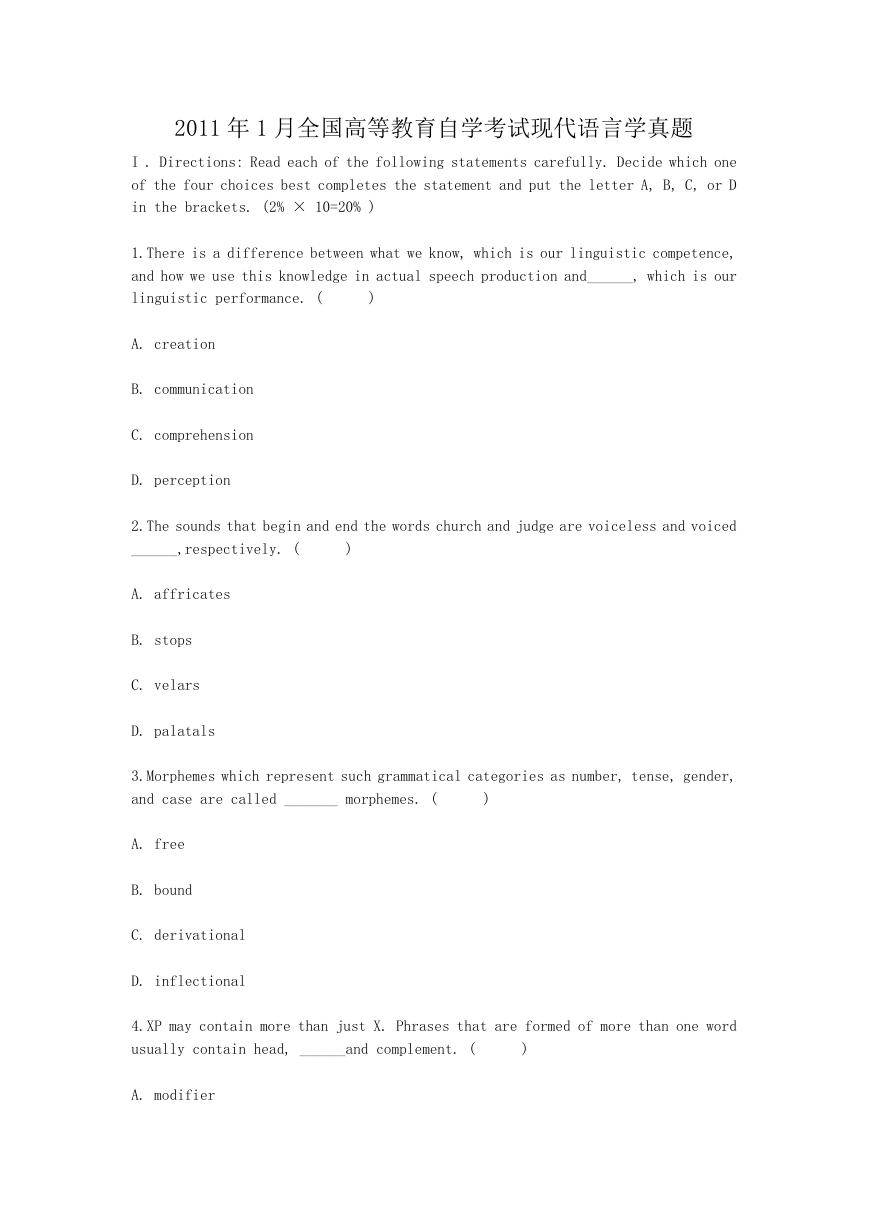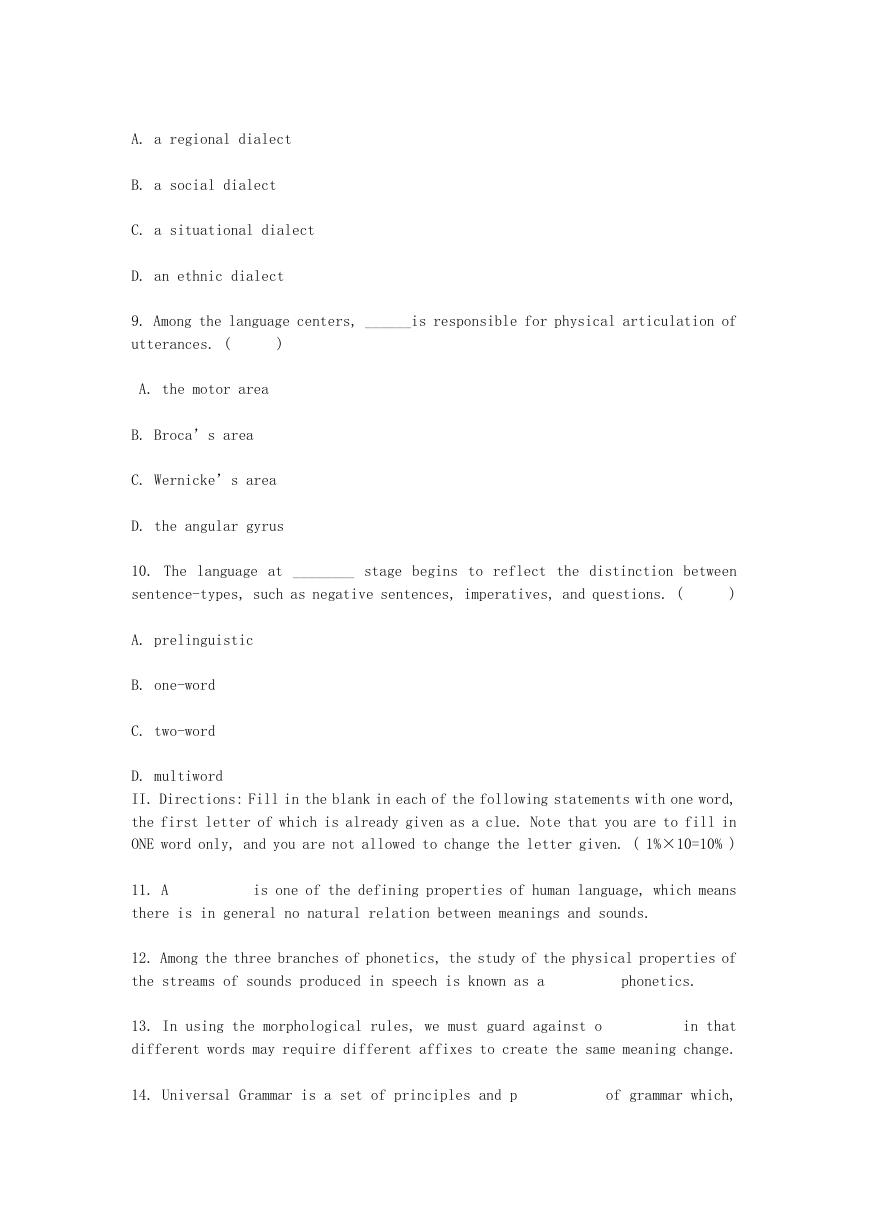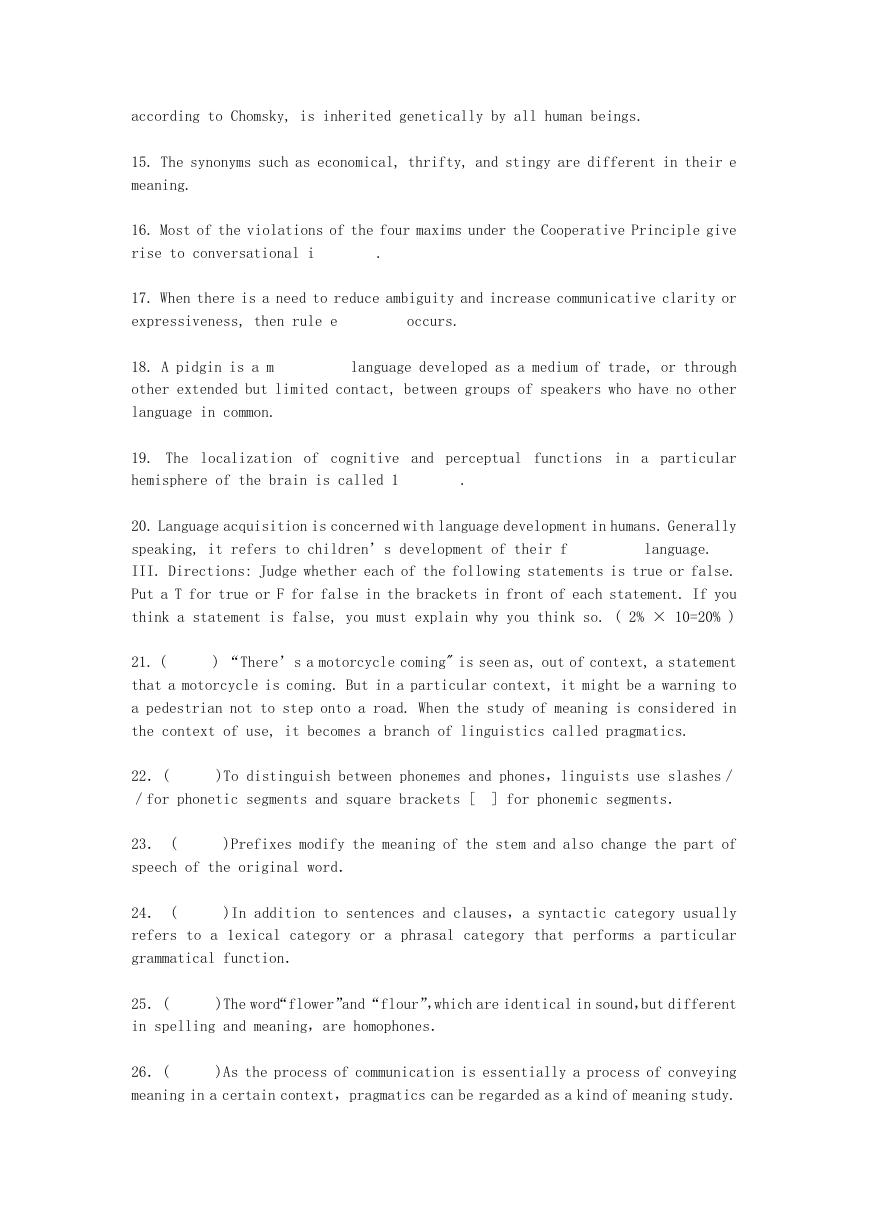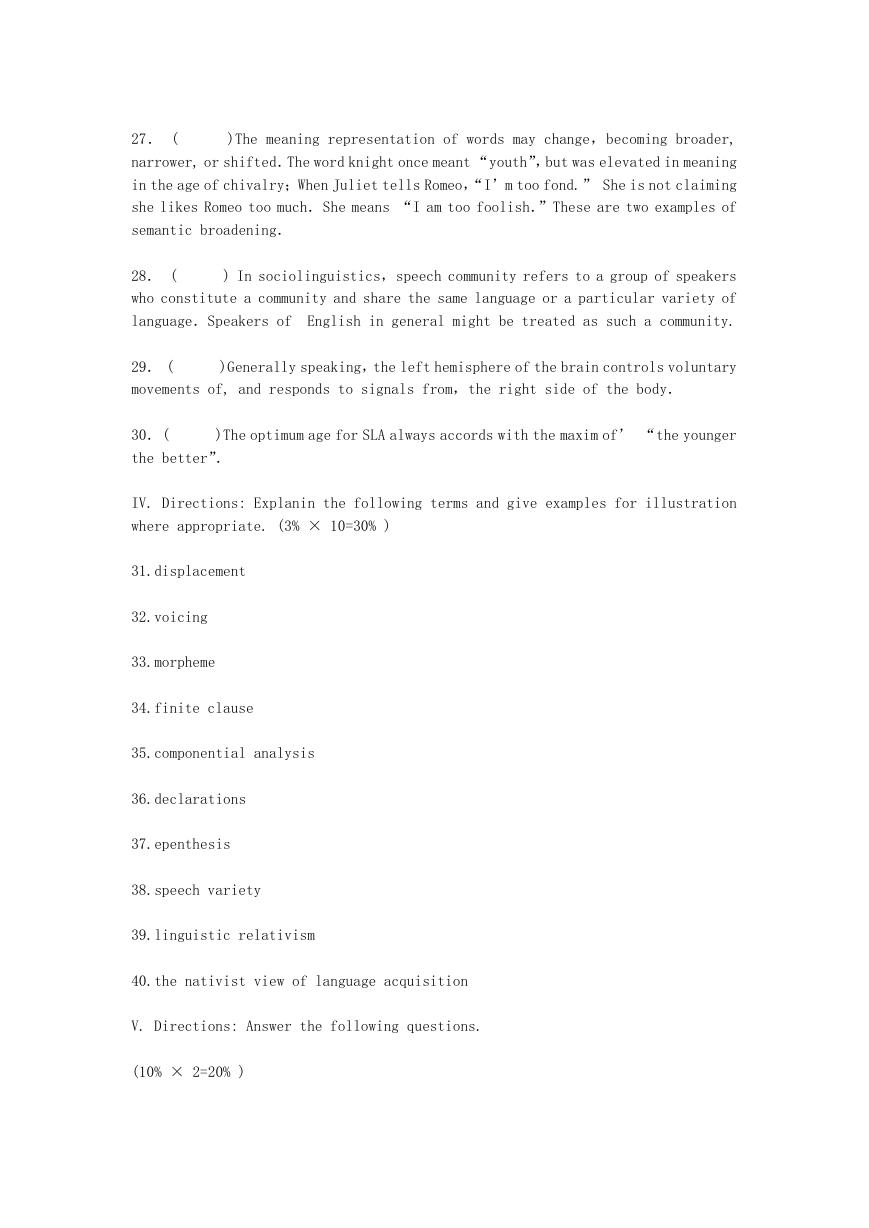2011 年 1 月全国高等教育自学考试现代语言学真题
I . Directions: Read each of the following statements carefully. Decide which one
of the four choices best completes the statement and put the letter A, B, C, or D
in the brackets. (2% × 10=20% )
1.There is a difference between what we know, which is our linguistic competence,
and how we use this knowledge in actual speech production and______, which is our
linguistic performance. (
)
A. creation
B. communication
C. comprehension
D. perception
2.The sounds that begin and end the words church and judge are voiceless and voiced
______,respectively. (
)
A. affricates
B. stops
C. velars
D. palatals
3.Morphemes which represent such grammatical categories as number, tense, gender,
and case are called _______ morphemes. (
)
A. free
B. bound
C. derivational
D. inflectional
4.XP may contain more than just X. Phrases that are formed of more than one word
usually contain head, ______and complement. (
)
A. modifier
�
B. determiner
C. qualifier
D. specifier
5. ______ is concerned with the inherent meaning of the linguistic form while _______
deals with the relationship between the linguistic element and non-linguistic world
of experience. (
)
A. Reference, sense
B. Sense, referent
C. Sense, reference
D. Referent, sense
6. According to John Austin’s theory of speech act, a(n) ______ act is the act of
expressing the speaker’s intention. (
)
A. prelocutionary
B. locutionary
C. illocutionary
D. perlocutionary
7. Sound changes may include the loss of a sound or sounds. The so-called apocope
refers to the omission of a vowel segment________. (
)
A. in word-initial
B. in word-middle
C. in word-final
D. in syllable-initial
8. In contrast to Standard American English, Black English is the distinct variety
of English native to black populations in the USA. We regard Black English as________.
(
)
�
A. a regional dialect
B. a social dialect
C. a situational dialect
D. an ethnic dialect
9. Among the language centers, ______is responsible for physical articulation of
utterances. (
)
A. the motor area
B. Broca’s area
C. Wernicke’s area
D. the angular gyrus
10. The language at ________ stage begins to reflect the distinction between
sentence-types, such as negative sentences, imperatives, and questions. (
)
A. prelinguistic
B. one-word
C. two-word
D. multiword
II. Directions: Fill in the blank in each of the following statements with one word,
the first letter of which is already given as a clue. Note that you are to fill in
ONE word only, and you are not allowed to change the letter given. ( 1%×10=10% )
11. A
there is in general no natural relation between meanings and sounds.
is one of the defining properties of human language, which means
12. Among the three branches of phonetics, the study of the physical properties of
the streams of sounds produced in speech is known as a
phonetics.
13. In using the morphological rules, we must guard against o
in that
different words may require different affixes to create the same meaning change.
14. Universal Grammar is a set of principles and p
of grammar which,
�
according to Chomsky, is inherited genetically by all human beings.
15. The synonyms such as economical, thrifty, and stingy are different in their e
meaning.
16. Most of the violations of the four maxims under the Cooperative Principle give
rise to conversational i
.
17. When there is a need to reduce ambiguity and increase communicative clarity or
expressiveness, then rule e
occurs.
18. A pidgin is a m
language developed as a medium of trade, or through
other extended but limited contact, between groups of speakers who have no other
language in common.
19. The localization of cognitive and perceptual functions in a particular
hemisphere of the brain is called 1
.
20. Language acquisition is concerned with language development in humans. Generally
speaking, it refers to children’s development of their f
III. Directions: Judge whether each of the following statements is true or false.
Put a T for true or F for false in the brackets in front of each statement. If you
think a statement is false, you must explain why you think so. ( 2% × 10=20% )
language.
21. (
) “There’s a motorcycle coming" is seen as, out of context, a statement
that a motorcycle is coming. But in a particular context, it might be a warning to
a pedestrian not to step onto a road. When the study of meaning is considered in
the context of use, it becomes a branch of linguistics called pragmatics.
22.(
/for phonetic segments and square brackets [
)To distinguish between phonemes and phones,linguists use slashes/
] for phonemic segments.
23. (
speech of the original word.
)Prefixes modify the meaning of the stem and also change the part of
)In addition to sentences and clauses,a syntactic category usually
24. (
refers to a 1exical category or a phrasal category that performs a particular
grammatical function.
25.(
in spelling and meaning,are homophones.
)The word“flower”and“flour”,which are identical in sound,but different
26.(
)As the process of communication is essentially a process of conveying
meaning in a certain context,pragmatics can be regarded as a kind of meaning study.
�
27. (
)The meaning representation of words may change,becoming broader,
narrower, or shifted.The word knight once meant “youth”,but was elevated in meaning
in the age of chivalry;When Juliet tells Romeo,“I’m too fond.” She is not claiming
she likes Romeo too much.She means “I am too foolish.”These are two examples of
semantic broadening.
28. (
) In sociolinguistics,speech community refers to a group of speakers
who constitute a community and share the same language or a particular variety of
language.Speakers of
English in general might be treated as such a community.
29. (
movements of, and responds to signals from,the right side of the body.
)Generally speaking,the left hemisphere of the brain controls voluntary
30.(
the better”.
)The optimum age for SLA always accords with the maxim of’ “the younger
IV. Directions: Explanin the following terms and give examples for illustration
where appropriate. (3% × 10=30% )
31.displacement
32.voicing
33.morpheme
34.finite clause
35.componential analysis
36.declarations
37.epenthesis
38.speech variety
39.linguistic relativism
40.the nativist view of language acquisition
V. Directions: Answer the following questions.
(10% × 2=20% )
�
41. What is the distinction between langue and parole? Why did Saussure make such
a distinction?
42. What are the differences between sentence meaning and utterance meaning? And
give examples to illustrate them.
�












 2023年江西萍乡中考道德与法治真题及答案.doc
2023年江西萍乡中考道德与法治真题及答案.doc 2012年重庆南川中考生物真题及答案.doc
2012年重庆南川中考生物真题及答案.doc 2013年江西师范大学地理学综合及文艺理论基础考研真题.doc
2013年江西师范大学地理学综合及文艺理论基础考研真题.doc 2020年四川甘孜小升初语文真题及答案I卷.doc
2020年四川甘孜小升初语文真题及答案I卷.doc 2020年注册岩土工程师专业基础考试真题及答案.doc
2020年注册岩土工程师专业基础考试真题及答案.doc 2023-2024学年福建省厦门市九年级上学期数学月考试题及答案.doc
2023-2024学年福建省厦门市九年级上学期数学月考试题及答案.doc 2021-2022学年辽宁省沈阳市大东区九年级上学期语文期末试题及答案.doc
2021-2022学年辽宁省沈阳市大东区九年级上学期语文期末试题及答案.doc 2022-2023学年北京东城区初三第一学期物理期末试卷及答案.doc
2022-2023学年北京东城区初三第一学期物理期末试卷及答案.doc 2018上半年江西教师资格初中地理学科知识与教学能力真题及答案.doc
2018上半年江西教师资格初中地理学科知识与教学能力真题及答案.doc 2012年河北国家公务员申论考试真题及答案-省级.doc
2012年河北国家公务员申论考试真题及答案-省级.doc 2020-2021学年江苏省扬州市江都区邵樊片九年级上学期数学第一次质量检测试题及答案.doc
2020-2021学年江苏省扬州市江都区邵樊片九年级上学期数学第一次质量检测试题及答案.doc 2022下半年黑龙江教师资格证中学综合素质真题及答案.doc
2022下半年黑龙江教师资格证中学综合素质真题及答案.doc